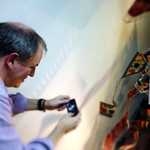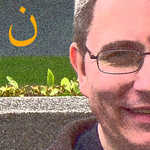Which way to the beach? Well, do we really need to ask?
It seems to me that, as our culture grows increasingly visual, we see more and more evidence of “semasiographic” modes of communication. “in which meanings, not words or sounds, are suggested by signs.” (I. J. Gelb, A Study of Writing, 1963, p. 11) Such signs may be highly conventional, like musical or scientific notation, or they may be more iconic, like road signs and garment care labels or even pictorial, like the surfer generated sign above. This picture takes us directly to the intended meaning while by-passing words and languages.
Many traditional historians of writing have significantly undervalued pictographic, hieroglyphic and all non-speech related forms of written communication, accepting only alphabetic script as ‘true writing’. Everything else is seen to be a primitive dead end. For instance, one of the most rigid and unwavering of these thinkers was John DeFrancis, who dismissed all semasiographic forms as “Partial/Limited/Pseudo/Non-Writing”.
Such unfortunate, one-eyed scholarship was little more than the twentieth century version of the primitive savage myth. So, for example, the highly sophisticated Mayan scribes of the Classic Meso-American civilization could be dismissed as illiterate, or non-literate, or at best preliterate. Similarly, dismissed were the Inca masters who developed the magnificent Khipu system of recording information, now known to be far more elaborate than a simple numeric recording system. Of course, here I can’t really develop these ideas in any detail, but by far the best place to start such thinking is with the highly readable, and profoundly seminal, volume, edited by Boone and Mignolo, Writing Without Words: Alternative Literacies in Mesoamerica and the Andes.
As the world becomes globalized and as computers and screens take over from books and documents, our written modes of conveying thought and transmitting ideas are changing dramatically. With the advent of hypertext and hypermedia, alphabetic writing is losing its linearity, historically one of its greatest strengths and at the same time, perhaps its greatest weakness. By simply embolding a word or phrase or sign, hypertext can jump straight to a song, dance, or mathematical derivation. Borges was the first European, perhaps, to foresee all this with his remarkable story The Garden of Forking Paths.
Indigenous ways of thinking are significantly advantaged by these technical developments, and in future I hope to present more thoughts about the importance of indigenous ways of knowing for the future of mankind.
Filed Under
Other moments in Dana Point
-
Dark Night of the Soul - an excerpt
in Dana Point, United States -
writing, Writers
A Writer's LIfe
in Dana Point, United States -
Back in Time
in Dana Point, United States -
writing
Writing...z-z-z-z
in Dana Point, United States -
Thoughts
Lost
in Dana Point, United States -
Fiction
Excerpt - Midnight Omen Deja vu
in Dana Point, United States -
writing, Books, Imagination
Books are the Stairway to the Imagination
in Dana Point, United States -
Life
"Life may not be the party we hoped for but while we are here, we might as well dance!"
in Dana Point, United States -
Full Moon
Full Honey Moon
in Dana Point, United States









